Presidency of Fidel Ramos
The Presidency of Fidel V. Ramos, also known as the Ramos Administration spanned for six years from June 30, 1992 to June 30, 1998. At the time of his assumption into power, Fidel Ramos was the third oldest person following Sergio Osmeña to become President of the Philippines at the age of 64 (Rodrigo Duterte surpassed this record upon being elected president at the age of 71 on May 9, 2016). He is also the first Protestant President of the country and the only Filipino officer in history to have held every one hundred rank in the Philippine military from Second Lieutenant to Commander-in-Chief. The first few years of his administration (1992–1995) were characterized by economic boom, technological development, political stability and efficient delivery of basic needs to the people. During his time, he advocated party platforms as outline and agenda for governance. As in his case, he was the first Christian Democrat to be elected in the country, being the founder of Lakas-CMD (Christian-Muslim Democrats Party). He was one of the most influential leaders and the unofficial spokesman of liberal democracy in Asia.[1]
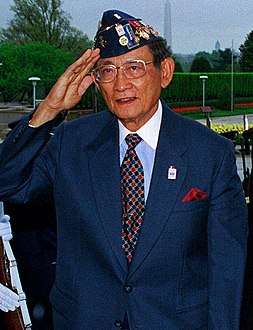 | |
| Presidency of Fidel Ramos | |
|---|---|
| June 30, 1992 – June 30, 1998 | |
| President | Fidel Ramos |
| Party | Lakas–CMD |
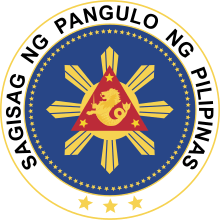 | |
Overview
Fidel V. Ramos, the 12th President of the Philippines (1992–1998), is remembered for steadfastly promoting the principles of people empowerment and global competitiveness. In 1993, he put an end to the power crisis that crippled Filipino homes and industries for two years. He pursued, focused and converged programs to fight poverty in accordance with the will of the Filipino people expressed by 229 structural/reform laws enacted by Congress during his term.
The Philippine economy recovered dramatically during the years 1993–1997. Ramos implemented a comprehensive Social Reform Agenda (SRA) that addressed the long-standing problem of poverty: jobs and livelihood, health, education and skills training, housing, environmental protection, children and the youth, the elderly and the handicapped, agrarian reform, and access to equal opportunity. The country's Gross National Product (GNP) averaged 5 percent annually. Average income of the Filipino family grew larger during his administration than in the preceding two decades. He pushed for the deregulation of key industries and the liberalization of the economy. He encouraged the privatization of public entities, to include the modernization of public infrastructure through an expanded Build-Operate-Transfer (BOT) law. While communist insurgency dwindled to historic lows, he achieved a peace agreement with military rebels and the secessionist Moro National Liberation Front (MNLF) for which he won for the Philippines the coveted 1997 UNESCO Peace Award—the first for Asians. FVR is known as the "Centennial" President, having planned and supervised the 100th Anniversary of the country's Declaration of Independence from Spain on 12 June 1998.
Administration and Cabinet
| |||||||||||||||||||||||||||||||||||||||||||||||||||||||||||||||||||||||||||||||||||||||||||||||||||||||||||||||||||||||||||||||||||||||||||||||||||||||||||||||||||||||||||||||||||||||||||||||||||||||||||||||||||||||||||||||||||||||||||||||||||||||||||||||||||||||||||
- President and Vice-President
 Fidel V. Ramos, President (1992-1998)
Fidel V. Ramos, President (1992-1998)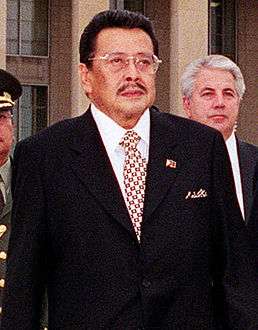 Joseph Ejercito Estrada, Vice-President (1992-1998) and Chairman of the Presidential Anti-Crime Commission (1992-1997)
Joseph Ejercito Estrada, Vice-President (1992-1998) and Chairman of the Presidential Anti-Crime Commission (1992-1997)
- Some of the Members of the Ramos Administration
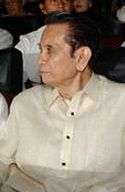 Teofisto Guingona, Jr., Secretary of Justice (1995-1998)
Teofisto Guingona, Jr., Secretary of Justice (1995-1998) Franklin Drilon, Secretary of Justice (1992-1995)
Franklin Drilon, Secretary of Justice (1992-1995) Perfecto R. Yasay, Jr., Chairman of the Securities and Exchange Commission (1995-1998)
Perfecto R. Yasay, Jr., Chairman of the Securities and Exchange Commission (1995-1998)- Richard J. Gordon, Chairman of the Subic Bay Metropolitan Authority (1992-1998)
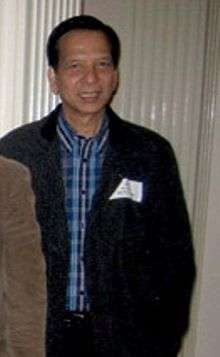 Ignacio Bunye, Chairman of the Metropolitan Manila Development Authority (1992)
Ignacio Bunye, Chairman of the Metropolitan Manila Development Authority (1992)
Judicial appointments
Ramos appointed the following to the Supreme Court of the Philippines:
- Justice Jose Melo - August 10, 1992
- Justice Jose C. Campos, Jr. - September 3, 1992
- Justice Camilo D. Quiason - February 1, 1993
- Justice Reynato Puno - June 28, 1993
- Justice Jose C. Vitug - June 28, 1993
- Justice Santiago M. Kapunan - January 5, 1994
- Justice Vicente V. Mendoza - June 7, 1994
- Justice Ricardo J. Francisco - January 5, 1995
- Justice Regino C. Hermosisima, Jr. - January 10, 1995
- Justice Artemio Panganiban - October 5, 1995
- Justice Justo P. Torres, Jr. - March 11, 1996
- Justice Antonio M. Martinez - November 10, 1997
- Justice Leonardo Quisumbing - January 15, 1998
- Justice Fidel P. Purisima - January 20, 1998 (his last SC justice appointee)
Major issues of Presidency
Ramos' speeches
- Inaugural Address, (30 June 1992)
- First State of the Nation Address, (27 July 1992)
- Second State of the Nation Address, (26 July 1993)
- Third State of the Nation Address, (25 July 1994)
- Fourth State of the Nation Address, (24 July 1995)
- Fifth State of the Nation Address, (22 July 1996)
- Sixth State of the Nation Address, (28 July 1997)
Major acts as President
Major treaties
- First RP-US Visiting Forces Agreement
Major legislation signed
- Republic Act No. 7653 - The New Central Bank Act .
- Republic Act No. 7638 - Charter of the Department of Energy.
- Republic Act No. 7648 - Electric Power Crisis Act.
- Republic Act No. 7832 - Anti-electricity and Electric Transmission Lines/Materials Pilferage Act of 1994.
- Republic Act No. 7881 – Amended certain provisions of RA 6657 and exempted fishponds and prawns from the coverage of CARP.
- Republic Act No. 7905 – Strengthened the implementation of the CARP.
- Republic Act No. 8179 - An act further liberalizing foreign investments, amending for the purpose Republic Act No. 7042, and for other purposes.
- Republic Act No. 8293 - The Intellectual Property Code of the Philippines (Philippine copyright law).
- Republic Act No. 8435 – (Agriculture and Fisheries Modernization Act AFMA) Plugged the legal loopholes in land use conversion.
- Republic Act No. 8532 – (Agrarian Reform Fund Bill) Provided an additional Php50 billion for CARP and extended its implementation for another 10 years.
Pardons
President Fidel Ramos issued pardons to the following:
- Actor Robin Padilla (1998) - convicted for illegal possession of firearms.[2]
Domestic policies
Economy
Overview
Ramos embarked on an ambitious development plan dubbed "Philippines 2000". Under the plan, several industries critical to economic development were privatized, such as electricity, telecommunications, banking, domestic shipping, and oil. The taxation system was reformed, and external debt was brought to more manageable levels by debt restructuring and sensible fiscal management. By 1996, the country's GNP and GDP were growing at a rate of 7.2 percent and 5.2 percent respectively. The annual inflation rate had dropped to 5.9 percent from its high of 9.1 percent in 1995. By the late 1990s, the Philippines' economic growth gained favorable comparisons with other Asian countries such as Taiwan, Thailand, South Korea, and Malaysia.
The Philippine economy took a sharp downturn during the Asian financial crisis of 1997. Its fiscal deficit in 1998 reached P49.981 billion from a surplus of P1.564 billion in 1997. The peso depreciated (fell in value) to P40.89 per U.S. dollar from its previous rate of P29.47 to a dollar. The annual growth rate of the GNP fell to 0.1 percent in 1998 from 5.3 percent in 1997. Despite these setbacks, the Philippine economy fared better than that of some of its Asian neighbors, and other nations praised the Ramos administration for its "good housekeeping."[3]
Philippines 2000
During his administration, Ramos began implementing economic reforms intended to open up the once-closed national economy, encourage private enterprise, invite more foreign and domestic investment, and reduce widespread corruption. Ramos was also known as the most-traveled Philippine President compared to his predecessors with numerous foreign trips abroad, generating about US$20 billion worth of foreign investments to the Philippines. To ensure a positive financial outlook on the Philippines, Ramos led the 4th Asia-Pacific Economic Cooperation (APEC) Leaders' Summit in the Philippines on November 1996. He also instituted reforms in the tax system which includes a forced increase on VAT (E-VAT law) from 4% to 10% mandated by World Bank and the International Monetary Fund.
Under his administration, the Philippines enjoyed economic growth and stability. His visions of 'Philippines 2000' led the country into a newly industrialized country in the world and the "Tiger Cub Economy in Asia".[4]
Philippines 2000 Five-Point Program:
- Peace and Stability
- Economic Growth and Sustainable Development
- Energy and Power Generation
- Environmental Protection
- Streamlined Bureaucracy
Power crisis
When Ramos was elected in May 1992, the Philippines had been experiencing widespread rotating power outages, known as "brownouts", for nearly a year; this happened suddenly when growing customer demand exceeded the reliable supply of electricity, which was mostly provided by the government-owned Napocor. It had been caused by the age and condition of the existing power plants, as well as the long-term lack of continuing investment in the energy sector. During his State of the Nation address on July 27, 1992, he requested that the Congress enact a law that would create an Energy Department to plan and manage the Philippines' energy sector. Congress not only created the Department of Energy, but gave the president special emergency powers to resolve the power crisis. Using those powers, Ramos issued licenses to independent power producers (IPP) to provide additional power plants within 24 months. Ramos issued supply contracts that guaranteed the government would buy whatever power the IPPs produced under the contract; the contracted prices were denominated in U.S. dollars to entice foreign investment in local power plants. Following the 1997 Asian Financial Crisis however, this structure became a problem, as the Philippine peso lost half of its value, and the local price for the contracted electricity essentially doubled. This resulted in the Philippine price of electricity becoming the second-highest in Asia, after Japan.
The country was already considered risky by investors due to previous coup attempts by military adventurists led by Gregorio Honasan, during the term of President Aquino; the almost daily brownouts lasting 4–12 hours also developed then. The perceived political instability and the reduced power supply severely limited investments and modernization in the country. During Ramos' term, the Philippines became a pioneer in the use of Build-Operate-Transfer (BOT) schemes to spur development, where, with limited government financial capability to do such, private investors are invited to build certain government projects (i.e. tollways, power plants, railways, etc.), operate them for a set period of time, and then transfer ownership to the government. There was little literature or previous experience with such schemes at the time; with the later unfavorable changes in the exchange rates and the business environment, some charge that these contracts put a large and undue amount of risk on the government and consumers.
Death penalty
While campaigning for the presidency, Fidel Ramos declared his support for reinstating the death penalty. Capital punishment was abolished for all crimes in 1987, making the Philippines the first Asian country to do so. In 1996 Ramos signed a bill that returned capital punishment with the electric chair (method used from 1923 to 1976, making Philippines the only country to do so outside U.S.) "until the gas chamber could be installed".[5] However, no one was electrocuted nor gassed, because the previously-used chair was destroyed earlier and the Philippines adopted the lethal injection. Some people were put to death by this means, until the death penalty was reabolished again in 2006.
Peace with separatists
Ramos, a military general himself, made peace with the rebel panels. He was instrumental in the signing of the final peace agreement between the government and the Moro National Liberation Front (MNLF) led by Nur Misuari in 1996. He also ordered the resumption of peace negotiations with the Moro Islamic Liberation Front (MILF) led by Salamat Hashim and the Communist Party of the Philippines-National Democratic Front, which operates the New People's Army, led by Jose Maria Sison.
Although he battled Communist rebels as a young lieutenant in the 1950s, Ramos made a bold move when he signed into law Republic Act 7636, which repealed the Anti-Subversion Law. With its repeal, membership in the once-outlawed Communist Party of the Philippines became legal.[6]
Agrarian reform
The Ramos administration speeded the implementation of the Comprehensive Agrarian Reform Program (CARP) of former President Corazon Aquino in order to meet the ten-year time frame. However, there were constraints such as the need to firm up the database and geographic focus, generate funding support, strengthen inter-agency cooperation, and mobilize implementation partners, like the non-government organizations, local governments, and the business community.[7] In 1992, the government acquired and distributed 382 hectares of land with nearly a quarter of a million farmer-beneficiaries. This constituted 41% of all land titles distributed by the Department of Agrarian Reform (DAR) during the last thirty years. But by the end of 1996, the DAR had distributed only 58.25% of the total area it was supposed to cover. From January to December 1997, the DAR distributed 206,612 hectares. That year, since 1987, the DAR had distributed a total of 2.66 million hectares which benefited almost 1.8 million tenant-farmers.[7]
One major problem that the Ramos administration faced was the lack of funds to support and implement the program.[7] The Php50 million, allotted by R.A. No. 6657 to finance the CARP from 1988 to 1998, was no longer sufficient to support the program. To address this problem, Ramos signed R.A. No. 8532 to amend the Comprehensive Agrarian Reform Law (CARL) which further strengthened the CARP by extending the program to another ten years.[7] Ramos signed this law on February 23, 1998 - a few months before the end of Ramos' term.[7]
Charter change
Among the proposed changes in the constitution included a shift to a parliamentary system and the lifting of term limits of public officials. Ramos argued that the changes will bring more accountability, continuity and responsibility to the "gridlock" prone Philippine version of presidential bicameral system. Some politically active religious groups, opposition politicians, business tycoons and left wing organizations opposed the Charter change process that was supposed to lead to a national referendum. Critics argued that the proposed constitutional changes for one would benefit the incumbent which during that time was Ramos. On September 21, 1997, a church organized rally brought in an estimated half a million people to Rizal Park.[8]
Furthermore, on September 23, 1997, charter change advocates suffered a setback when the Supreme Court, under Chief Justice Andres Narvasa, narrowly dismissed a petition filed by the People's Initiative for Reform, Modernization and Action (PIRMA) that sought to amend the Constitution through a signature campaign or "People's Initiative". The Supreme Court dismissed the petition on the grounds that the People's Initiative mode does not have enough enabling law for the proposed revisions or amendments in the 1987 constitution. Had the petition been successful, a national plebiscite would have been held for proposed changes.[8]
Foreign Policies
Overview
The Ramos administration from June 1992 to June 1998 defined the four core priorities of Philippine foreign policy namely: the enhancement of national security, promotion of economic diplomacy, protection of overseas Filipino workers and Filipino nationals abroad, and the projection of a good image of the country abroad.
President Ramos boosted foreign trade, investments and official development assistance to the Philippines through his state visits and summit meetings. In 1996, the Philippines successfully hosted the APEC Leaders' Summit, which resulted in the Manila Action Plan for APEC 1996 (MAPA '96).
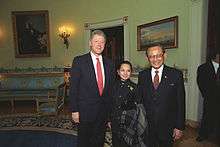
The Migrant Workers and Overseas Filipinos Act of 1995 (R.A. 8042) provided a framework for stronger protection of Filipino workers abroad, with the creation of the Legal Assistance Fund and the Assistance-to-Nationals Fund, and the designation in the DFA of a Legal Assistant for Migrant Workers' Affairs, with the rank of Undersecretary of Foreign Affairs.[9]
Among the other significant events in foreign affairs during the Ramos years were: the adoption by ASEAN in 1992, upon Philippine initiative, of the Declaration on the Conduct of Parties in the South China Sea aimed at confidence-building and avoidance of conflict among claimant states; the establishment of the Brunei, Indonesia, Malaysia, and Philippines (BIMP)-East Asia Growth area in 1994; the establishment of the ASEAN Regional Forum (ARF) in 1994 as the only multilateral security dialogue in the Asia-Pacific region conducted at the government level; and the signing between the Philippine Government and the Moro National Liberation Front on 2 September 1996 of the Mindanao Peace Agreement.[9]
Spratly Islands
In early 1995, the Philippines discovered a primitive Chinese military structure on Mischief Reef in the Spratly Islands, one hundred and thirty nautical miles off the coast of Palawan. The Philippine government issued a formal protest over China's occupation of the reef and the Philippine Navy arrested sixty-two Chinese fishermen at Half Moon Shoal, eighty kilometers from Palawan. A week later, following confirmation from surveillance pictures that the structures were of military design, President Fidel Ramos had the military forces in the region strengthened. He ordered the Philippine Air Force to dispatch five F-5 fighters backed by four jet trainers and two helicopters, while the navy sent two additional ships. The People's Republic of China had claimed that the structures were shelters for fishermen but these small incidents could have triggered a war in the South China Sea.
Migrant Workers Protection
One of the downturns of his administration was his experience in handling migrant workers protection. On the eve of his 67th birthday on March 17, 1995, Ramos was on a foreign trip when Flor Contemplación was hanged in Singapore. His last minute effort to negotiate with Singapore President Ong Teng Cheong and Prime Minister Goh Chok Tong never succeeded and he was marred with protests after his return to Manila. The protests also caused the resignation of Foreign Affairs Secretary Roberto Romulo and Labor Secretary Nieves Confesor from the Cabinet. He immediately recalled Philippine ambassador to Singapore Alicia Ramos and suspended diplomatic relations to Singapore. He created a special commission to look into the case and to try to rescue his sagging popularity. The commission was led by retired justice Emilio Gancayco. The Commission recommended the forced resignation of then Overseas Workers Welfare Administration (OWWA) head David Corpin and 13 other government officials, including two labor attachés.
As also recommended by the Gancayco Commission, Ramos facilitated the enactment of Republic Act 8042, better known as the Magna Carta for Overseas Workers or the Migrant Workers Act. The Migrant Workers Act was signed into law on June 7, 1995. Learning from the lessons of Contemplación case, Ramos immediately ordered UAE Ambassador Roy Señeres to facilitate negotiations after learning the death penalty verdict of Sarah Balabagan on September 1995. Balabagan's sentence was lowered and she was released August 1996. After tensions cooled off, Ramos restored diplomatic relations with Singapore after meeting Prime Minister Goh Chok Tong during the sidelines of the 50th anniversary of the United Nations in New York City.
World Trade Organization
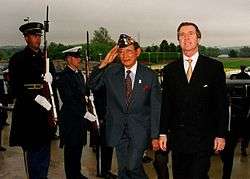
It was during the Presidency of Fidel Ramos that the Philippines became a member of the World Trade Organization which is an organization that intends to supervise and liberalize international trade. The organization officially commenced on January 1, 1995 under the Marrakech Agreement, replacing the General Agreement on Tariffs and Trade (GATT), which commenced in 1948. The organization deals with regulation of trade between participating countries; it provides a framework for negotiating and formalizing trade agreements, and a dispute resolution process aimed at enforcing participants' adherence to WTO agreements which are signed by representatives of member governments and ratified by their parliaments.[10][11] Most of the issues that the WTO focuses on derive from previous trade negotiations, especially from the Uruguay Round (1986–1994).
Asian Financial Crisis
The 1997 Asian Financial Crisis, which started in Thailand, was a major blow to the Ramos administration. The economy was hit by currency devaluation.[12] The same was true for the Thai baht, Malaysian ringgit, and Indonesian rupiah. Growth fell to about -0.6% in 1998 from 5.2% in 1997, but recovered to 3.4% by 1999. It also resulted to the shutdown of some businesses, a decline in importation, a rise in unemployment rate and an unstable financial sector.
Controversies
Clark Centennial Expo Scandal
Supposedly, one of his notable contributions to the Philippines was the revival of nationalistic spirit by embarking on a massive promotion campaign for the centennial of Philippine Independence celebrated on June 12, 1998. However, charges of alleged massive corruption or misuse of funds blemished the resulting programs and various projects, one of which was the Centennial Expo and Amphitheater at the former Clark Air Base in Angeles City, Pampanga, supposedly Ramos' pet project. The commemorative projects, particularly those undertaken at the former Clark Air Base, were hounded by illegal electioneering and corruption controversies even years after the Centennial celebrations. A special report by the Philippine Center for Investigative Journalism (PCIJ) showed how the projects relating to the Expo site not only revealed the extravagance and inefficiency of the administration, but also served as convenient vehicle to effect election fund-raising for the LAKAS political party of Ramos at the expense of the tax-paying Filipinos and in violation of the Election Code. The Centennial Expo Pilipino project, intended to be the centerpiece for the celebrations for the 100th anniversary of the country's independence from Spain, also earned extensive criticisms for being an expensive white elephant project that disadvantaged the government at the cost of P9 billion, or 1.7 percent of the country's 1998 national budget.[13] Six ranking Ramos cabinet members and officials, headed by Chairman Salvador Laurel (former Vice-President) of the Centennial Commission were cleared by the Ombudsman and Sandigan Bayan (People's Court). Ramos appeared before a Congressional Committee in October 1998 to help exonerate said officials of any wrongdoing.
PEA-Amari Scandal
President Fidel Ramos was accused of corruption in the PEA-Amari deal. The controversial deal involved the acquisition of 158 hectares of reclaimed land on Manila Bay that was to be converted into so-called Freedom Islands. The deal was forged in April 1995 as part of the Ramos administration's Manila Bay Master Development Plan (MBMDP).
The PEA-Amari deal – in addition to other projects in Manila Bay - displaced over 3,000 fishing and coastal families in Manila Bay just to give way to what fisherfolk activists from Pambansang Lakas ng Kilusang Mamamalakaya ng Pilipinas (Pamalakaya) described as "an immoral, illegal and grossly unconstitutional state venture". Ramos denied accusations that the PEA-Amari deal was clinched to benefit members of the ruling Lakas-NUCD as alleged by opposition groups. However, ex- solicitor general Franciso Chavez filed a petition to nullify the PEA-Amari deal because the government stood to lose billions of pesos in the sale of reclaimed lands to Amari.
On April 25, 1995, PEA entered into a joint venture with Amari to develop Freedom Islands and on June 8 of the same year, Ramos okayed deal. On November 29, 1996, then-Senate President Ernesto Maceda delivered a privilege speech assailing the deal as the "grandmother of all scams".[14]
Role in EDSA 2 ouster of President Joseph Estrada
A longstanding criticism of Ramos was whether his role in the Estrada ouster was motivated by his fear of being prosecuted in connection with the Centennial Expo and other scams. When Estrada was given executive clemency after having been found guilty of plunder by the special Sandiganbayan court in September 2007, Ramos heavily criticized Arroyo's decision. Estrada's son, Sen. Jinggoy Estrada, retaliated by asking Ramos to first "come clean" on the alleged multi-billion-peso anomalies involved in the PEA-AMARI, IPP and other deals negotiated during his term.
Unsound Economic Policies
Leftist groups have also criticised Ramos' economic reforms such as privatization, deregulation and trade liberalization, claiming that the economic growth posted during his presidency was "artificial." They blamed him for the slowdown of the Philippine economy during the 1997 East Asian financial crisis. The sale of Petron to Aramco is specifically criticized as resulting to the loss of the government's effective leverage on domestic oil prices. Along with the deregulation of the entire oil industry, Petron's privatization is blamed for the continuing surge in oil prices that has particularly proved to be deleterious to the masses amidst the obtaining high petroleum costs in the global market.
In 1998, Ramos hesitantly admitted that, contrary to what his government earlier claimed, the economic fundamentals of the country may actually be unsound. His admission came following the discovery of a secret memorandum issued by the National Economic Development Authority director-general during the president to tell the Filipinos the truth about the state of the economy and that they ought to prepare for worse. According to former University of the Philippines president Francisco Nemenzo, Ramos "has done nothing to reverse or slow down the implementation" of the harmful IMF-imposed structural reforms.
Wikileaks Exposé
On August 30, 2011, Wikileaks exposed reports sent by the United States Embassy in Manila that contain detail that the Libyan government under Muammar Gaddafi allegedly contributed US$20,000 to the presidential campaign of Ramos in 1992.[15] The report said it was former House Speaker Jose de Venecia who brought Ramos to Gaddafi.[16] Reports said that Ramos and De Venecia "had been engaged in shady dealings in both Libya and Iraq involving construction contracts for his firm, and had tried to "repay" his Libyan benefactors by acting as their front man and errand boy." The same report added that there was a lot of speculation when Ramos and De Venecia left for a secret trip abroad in middle of the 1992 campaign, and implied that this connection with the Libyan government was one of the objectives.
Section 95 of the Philippines' Omnibus Election Code enumerates prohibited sources of political contributions and one of them is " Foreigners and foreign corporations." In addition, "It shall be unlawful for any person to solicit or receive any contribution from any of the persons or entities enumerated herein," the Code said. Sec. 81 of the Code also states,"It shall be unlawful for any foreigner, whether judicial or natural person, to aid any candidate or political party, directly or indirectly, or take part in or influence in any manner any election, or to contribute or make any expenditure in connection with any election campaign or partisan political activity." The Wikileaks exposé makes Ramos administratively and criminally liable under the law. If charged and convicted for this offense, he can be fined and imprisoned.[17]
Midterm Elections
Legislative elections and local elections were held in the Philippines on May 8, 1995 - halfway through President Ramos' six-year term. Filipinos protected the ballot boxes with their lives and campaigned against traditional politicians who used bribery, flying voters, violence, election rigging, stealing of ballot boxes etc. The Philippine National Police (PNP) had listed five dead and listed more than 200 hotspots before the election and during the election day listed 300 hotspots. Ramos' administration-coalition won 9 senate seats and a majority of the seats in the house.
Philippine Centennial Celebrations
On June 12, 1998, the nation celebrated its centennial year of independence from Spain. The celebrations were held simultaneously nationwide by then President Fidel V. Ramos and Filipino communities worldwide. A commission was established for the said event, the National Centennial Commission headed by former Vice President Salvador Laurel presided all events around the country. One of the major projects of the commission was the Expo Pilipino, a grand showcase of the Philippines' growth as a nation for the last 100 years, located in the Clark Special Economic Zone (formerly Clark Air Base) in Angeles City.
End of presidency
Ramos was the first president under the 1987 constitution to be barred of seeking another term. His predecessor, Corazon Aquino, was still eligible to run for president since she took office under the 1973 Constitution. As his term was winding down he was pushing for constitutional amendments, however did not succeed.(Further Information: Charter Change under President Fidel V. Ramos)
Nonetheless, Ramos supported his friend then-Speaker Jose de Venecia, Jr. for the 1998 presidential election. However the latter lost to Ramos' Vice-President, Joseph Estrada. On June 30, 1998, outgoing President Fidel Ramos accompanied his successor to the Barasoain Church in Malolos, Bulacan for the oath-taking rights and later at the Quirino Grandstand in Luneta for the inaugural address.
References
- "Fidel Ramos".
- "Phno: Showbiz Chatter". Newsflash.org. 1998-04-08. Retrieved 2012-06-05.
- "CIA - The World Factbook". Cia.gov. Retrieved 2012-06-05.
- Gregorio F. Zaide, Sonia M. Zaide (2004), Philippine History and Government, Sixth Edition, All-Nations Publishing Co. (Quezon City), p. 180
- McLean, John (2003-12-21). "Philippines 'restores' death penalty". BBC News. Retrieved 2012-06-05.
- "Moves to revive the Anti-Subversion Law". Newsinfo.inquirer.net. 2007-12-14. Archived from the original on 2012-08-06. Retrieved 2012-06-05.
- Manapat, Carlos, et al. Economics, Taxation, and Agrarian Reform. Quezon City: C&E Pub., 2010.Print.
- "Gloria and cha-cha - Research". GMANews.TV. 2008-08-13. Retrieved 2012-06-05.
- "History of the Department of Foreign Affairs". Dfa.gov.ph. 2009-07-02. Retrieved 2012-06-05.
- Understanding the WTO - what is the World Trade Organization?, World Trade Organization
- "World Trade Organization". Encyclopædia Britannica.
- Tuaño, Philip Arnold P. (January 2002). "The Effects of the Asian Financial Crisis on the Philippines Labor Market" (PDF). Regional Project on the Social Impact of the Asian Financial Crisis. East Asian Development Network. Archived from the original (PDF) on September 22, 2007. Retrieved July 19, 2009.
- Alecks Pabico. "Centennial Expo: Convenient Cover for Election Fundraising". Pcij.org. Archived from the original on 2015-07-25. Retrieved 2012-06-05.
- "PEA-Amari Electoral Controversy". Members.tripod.com. Retrieved 2012-06-05.
- "Cable Viewer". Wikileaks.org. Retrieved 2012-06-05.
- VERA Files (2011-09-03). "Wikileaks:Ramos got P5M campaign contribution from Gaddafy". The Inbox - Yahoo! News Philippines. Retrieved 2012-06-05.
- "COMELEC Pertinent Laws | Omnibus Election Code". Comelec.gov.ph. Archived from the original on 2012-05-29. Retrieved 2012-06-05.